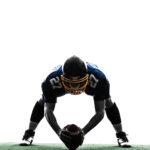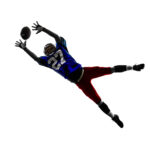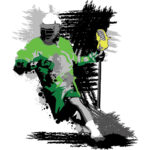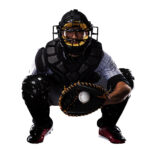
By Carl Valle
Every sport is different, but many field sports that involve running have similarities in demands, and testing the player abilities can ensure the performance program is properly developing the athlete. When setting priorities in training, a baseline test early in the preparatory phase is essential to creating realistic goals based on the amount of time one has to train and the starting point of the athlete based on the results. To evaluate an athlete properly, several options exist to discovering the fitness and speed of an athlete. Sometimes a specific quality may n to be essential, such as conditioning for American Football during the winter when speed development is precious. On the other hand, not testing conditioning for soccer is essential and should be done multiple times during the year, not just before the season starts. Testing core performance abilities, also known as biomotor abilities to many coaches, is the cornerstone to evaluating if programs are actually doing what they intend in doing with development.
Biomotor Abilities
Most sports have the inclusion of five primary abilities that can be improved by training, with physical size (added mass) and mental talents that are more subjective and not tested by electronic timing and video analysis. The fusion of timing with Freelap and the use of smartphone apps such as the Dartfish Express app, properly explains the key areas of performance and are easily done together naturally. Frank Dick, the British coach legend who worked with athletes outside of track and field coined the five biomotor abilities in his classic text Sports Training Principles. They are the following:
Components to Athletic Performance
- Speed (acceleration and top speed)
- Stamina (specific endurance and work capacity)
- Skill (coordination abilities)
- Suppleness (flexibility and mobility)
- Strength (general abilities and power)
Note the two biomotor abilities, Speed and Stamina are the most straightforward in assessing, and the later three requires interpretation and outside testing. Regardless, one can make a case that the bottom three contribute to the most important, the ability of athletes to be fast enough to make the play, and be fit enough to make more plays repeatedly. Video analysis can help capture the other contributions with either additional testing or training, or see the biomotor abilities in more detail during the tests. A cause and effect analysis is very clear when performance numbers are combined with video to share why someone is performing well or not. For the same of importance let’s see the top tests in no particular order and see why they are valuable and how one can use the tests for athletes to develop them.
Starting Speed (acceleration abilities)

Short sprints of up to 40 meters are the most useful tests and most simple to interpret. By adding splits of every 10 m, a coach can get more in-depth information based on how the athlete is accelerating in general. Most sports start with a walking or stationary position before exploding, so it’s important to see how they are accelerating in short distances and follow up to see how they get to their top speed. Timing short sprints can be a simple as getting the total time of a 15-20 m sprint, or get extensive information of sprints from 0 to 40 meters. With most sports achieving top speed or terminal acceleration near the 30 m mark if the athlete starts in a standing position, the last 10 meters can be a great test for many to get their top speed, something that will be discussed in more detail next.
Max Speed (top speed ability)

Some situations it’s good to get an idea how fast an athlete can if the sport has plays that could be longer than the first 20 m. Most plays will be short in sports such as basketball, but athletes being exposed to higher than game speeds creates two key benefits. First, the injury prevention or reduction benefit of exposing the hamstrings and other muscle groups to overload is an effective way to prepare for game speed. Athletes need a target or perspective to reach when accelerating, so top speed testing is a good way to prepare an athlete for performance and resiliency to the body. Some coaches are scared to test speed because some athletes may get hurt in practice, but not preparing is rolling the dice when the rubber hits to road, or in this case the cleat or athletic shoe hits the field or court. Setting up to test a ten meter fly is easy, and more information on testing the maximum speed of an athlete can be found here.
Repeated Speed (repeated-sprint ability or RSA)

The common test in soccer and other field sports is a series of sprints with abbreviated rest to me sure something known to sport science and coaching as Repeated-Sprint Ability or RSA for short. One of the most debated areas in coaching is properly preparing an athlete to achieve great ability to sprint fast over and over. Regardless of philosophy, better prepared athletes will not only run fast to begin with, they will run fast over and over. It’s important to realize that doing repeated sprinting with shortened rest periods to develop RSA may be not as important if athletes are doing sufficient volumes of sprints with longer rest periods, because more than one way exists to improve the ability than simply replicating the test. High volume sprints fatigue the body as do abbreviated rest periods, but not as much. Fortunately lower speed running that doesn’t fatigue athletes for sprints can be placed into training and will not be incompatible to developing absolute speed abilities while helping conditioning concurrently. No matter what test one uses, such as the total amount of sprints, the specific distance and rest period, and the interpretation after, the most important and primary element is timing the athlete’s all out sprint at the distance tested for RSA. The most obvious need is to create comparison, how fast the athlete can sprint compared to repeated runs is essential to prevent pacing (not going all out) and to see if the athlete is fast enough to worry about their repeated bouts to begin with. Freelap is great because two athletes can share the transmitter by running next to each other and the rest periods can be audited later when exported to a spreadsheet software like google docs or excel.
Agility (gross change of direction-lateral or side to side)

Straight ahead speed or linear speed does have carryover or transfers to lateral speed, but testing the 5-10-5 or any change of direction test one believes to be a good raw indication of agility. Notice the term raw or general, since each sport with have so many different patterns of agility that testing each action is unrealistic and just general small sided games and practices should be adequately preparing for those movements. Still, a global sense of change of direction abilities is helpful to see deceleration, the compliment to great acceleration ability. General deceleration training is very helpful in reducing joint injuries such as the ACL, and coaches can see the effects of their movement instruction and strength training programs on the scores when timed and video captured.
Stamina (Sustained Repeated Running)

Similar to RSA, many conditioning tests such as the Yo-Yo Intermittent Recovery Test 2 or 30-15 test are simply shuttled runs with various distances and recovery times over a prolonged period. The stage running tests are excellent ways to see aerobic capacity by replicating conditions similar to games, and the validity and sensitivity to the tests are excellent. Timing shuttle tests can be done easily with Freelap and just one Junior transmitter , a receiver watch, and a cone. One of the strongest features of Freelap is exporting the data to excel or other electronic spreadsheet program to convert into other units of measurement such as Kilometers per hour, meters per second, or even miles per hour for translating to imperial units for our American coaches still stuck in yards and miles. The great benefit to using the watch is an athlete can be tested with an additional transmitter and be tested on their own without much supervision if coaches are in demand with return to play (rehabilitation training) training or just occupied at that time. Workouts sometimes can we tests themselves such as timing tempo runs and seeing if athletes are getting tired if other data sets such as heart rate monitors or fatigue questionnaires are used.
Closing Thoughts on Testing
All five tests interact and have relationships. An athlete with very poor shuttle conditioning is likely not to be excelling at RSA tests or athletes that are slow in top speed testing with good early acceleration may better suited in being a running back instead of a wide receiver. Testing is not about just seeing the abilities of the tests, it’s about seeing the interrelation between all testing. Sometimes a great score in one test will serve a marker of unexpected imbalance, such as an athlete inappropriately focusing on one ability too long and diluting other abilities. One example is an athlete focused only on straight ahead speed for the purposes of scouting, free agent evaluation, or college recruiting, and then showing up with little deceleration abilities in camp and getting hurt. Using smartphones allows coaches to see if flexibility, mobility, stability, and strength training is actually transferring by looking at both the performance data of the times and the video to see evidence of changes in kinematics or technique. Just testing once a year at the same time is enough to see career improvement, but more frequent testing is helpful, and since the tests are great workouts themselves, this should be easy to implement into current training programs.
Please share this article so others may benefit.
[mashshare]


